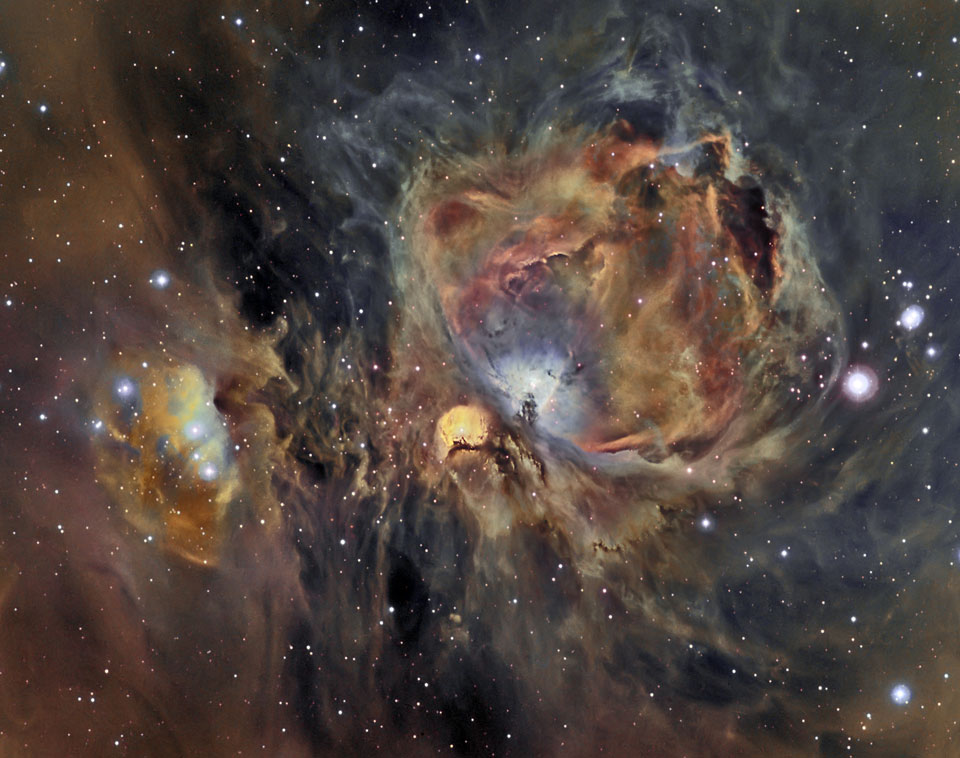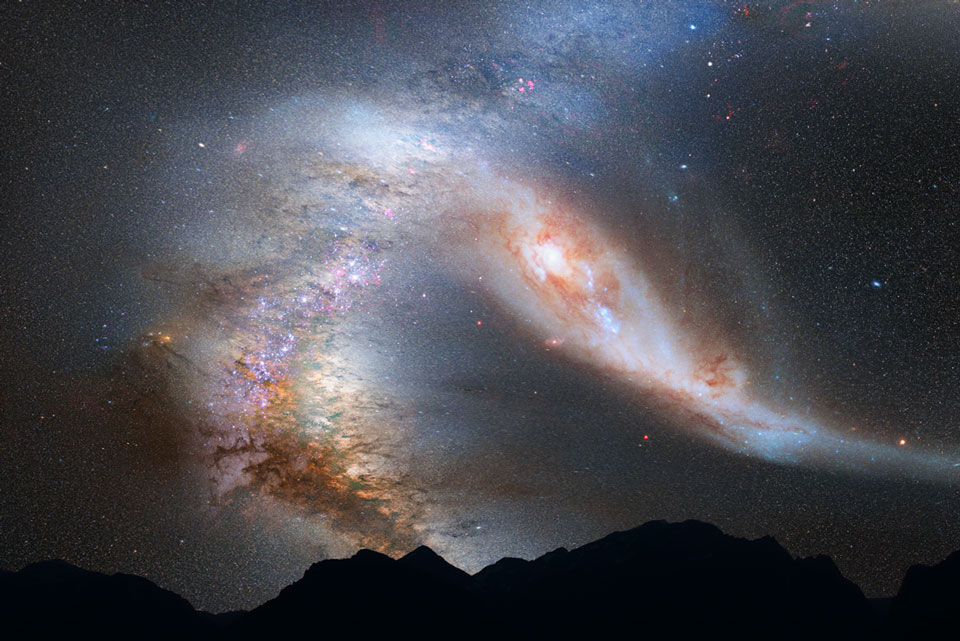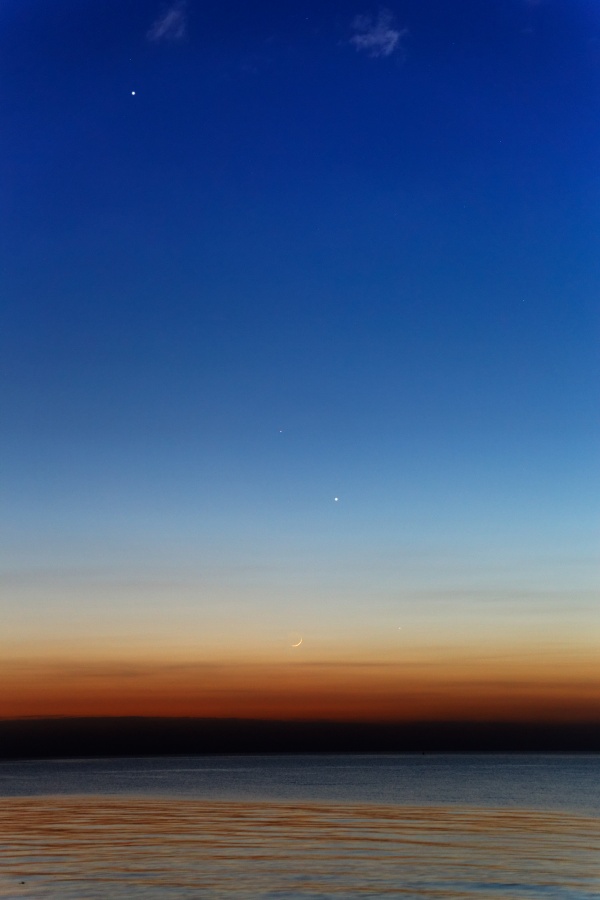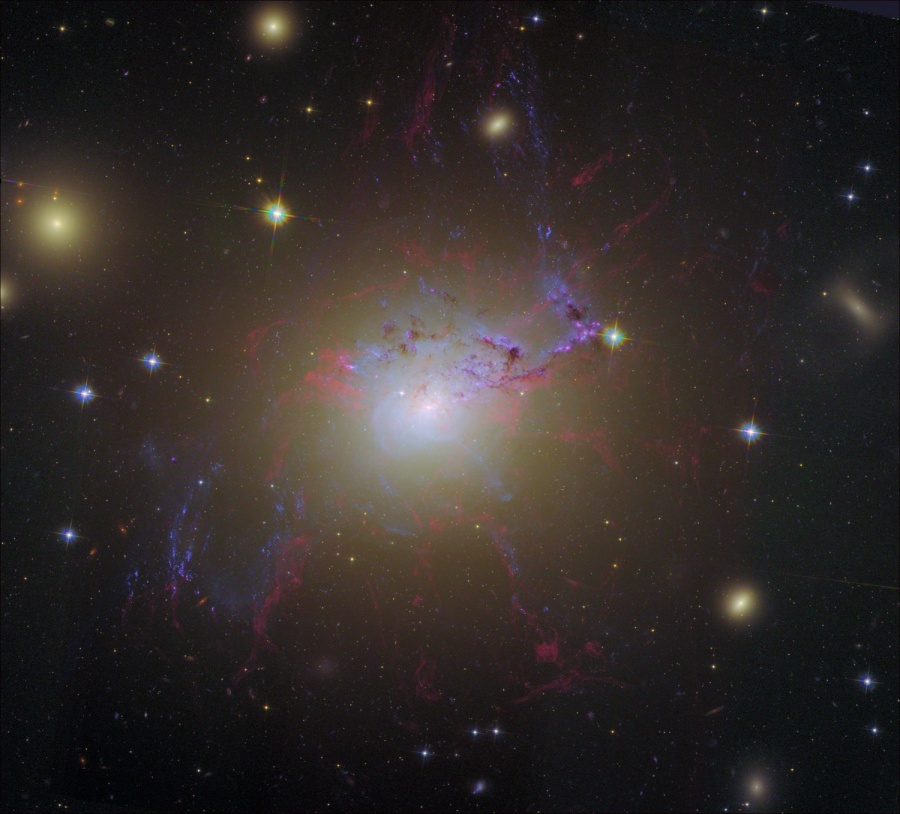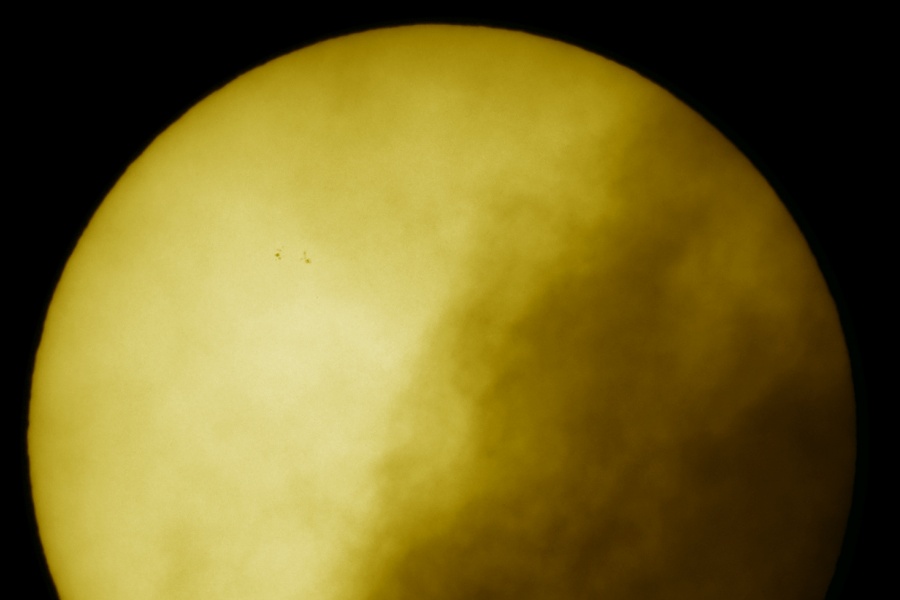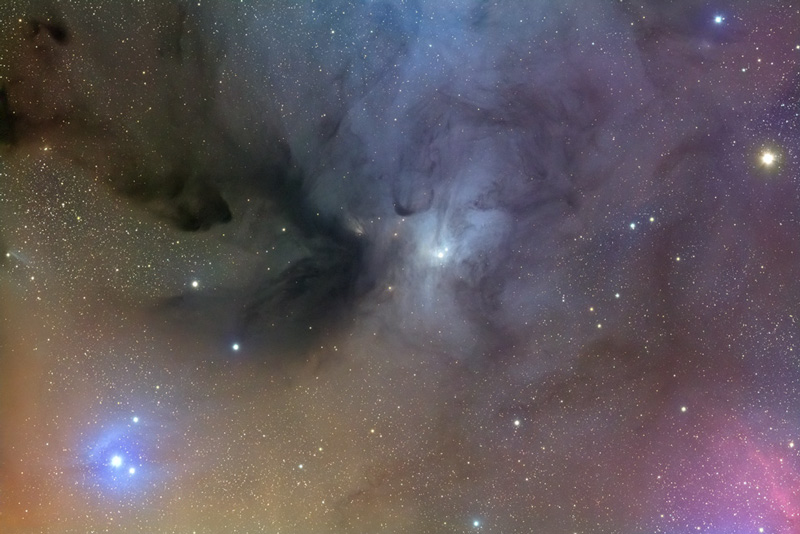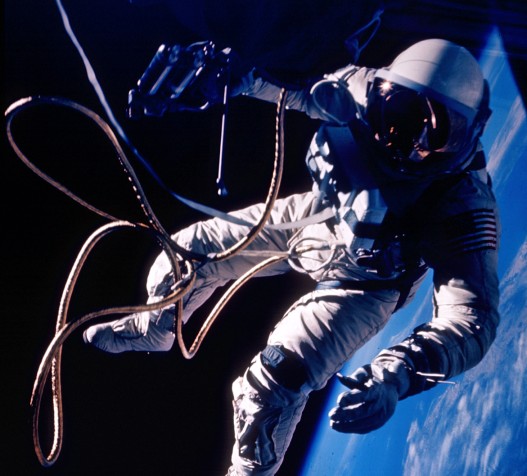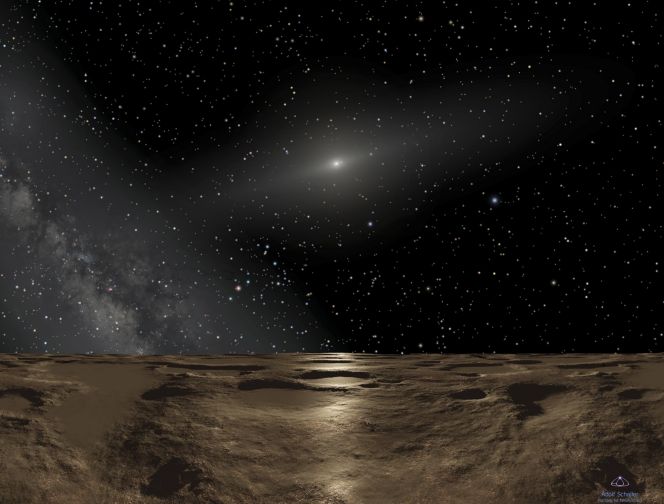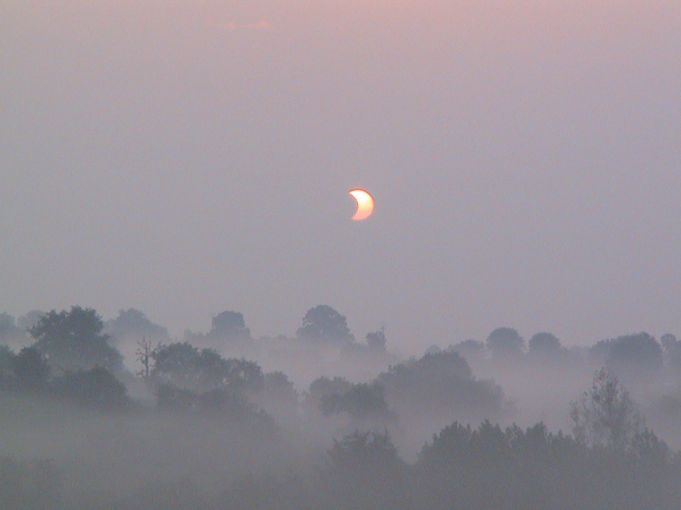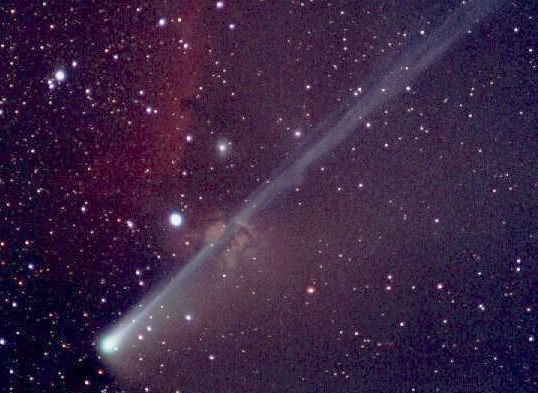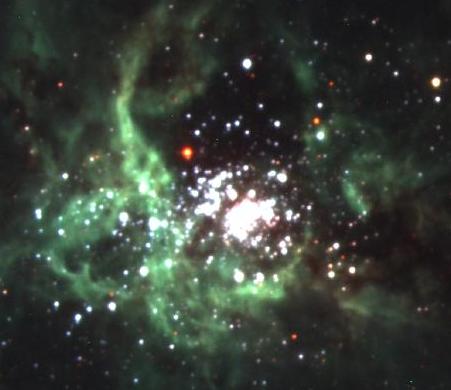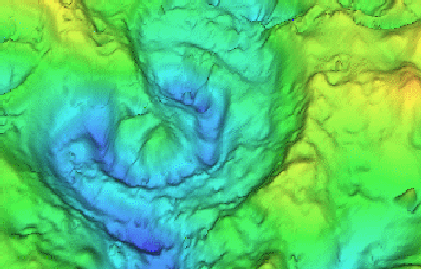| << Previous | Index | Next >> |
2015 Three objects stand out in this thoughtful telescopic image, a view toward the mostly stealthy constellation Lynx. The two brightest (the spiky ones) are nearby stars. The third is the remote globular star cluster NGC 2419, at distance of nearly 300,000 light-years. NGC 2419 is sometimes called "the Intergalactic Wanderer", an appropriate title considering that the distance to the Milky Way's satellite galaxy, the Large Magellanic Cloud, is only about 160,000 light-years. Roughly similar to other large globular star clusters like Omega Centauri, NGC 2419 is itself intrinsically bright, but appears faint because it is so far away. NGC 2419 may really have an extragalactic origin as, for example, the remains of a small galaxy captured and disrupted by the Milky Way. But its extreme distance makes it difficult to study and compare its properties with other globular clusters that roam the halo of our Milky Way galaxy.
2014 Many think it is just a myth. Others think it is true but its cause isn't known. Adventurers pride themselves on having seen it. It's a green flash from the Sun. The truth is the green flash does exist and its cause is well understood. Just as the setting Sun disappears completely from view, a last glimmer appears startlingly green. The effect is typically visible only from locations with a low, distant horizon, and lasts just a few seconds. A green flash is also visible for a rising Sun, but takes better timing to spot. A dramatic green flash, as well as an even more rare red flash, was caught in the above photograph recently observed during a sunset visible from the Observatorio del Roque de Los Muchachos in the Canary Islands, Spain. The Sun itself does not turn partly green or red -- the effect is caused by layers of the Earth's atmosphere acting like a prism.
2013 Few astronomical sights excite the imagination like the nearby stellar nursery known as the Orion Nebula. The Nebula's glowing gas surrounds hot young stars at the edge of an immense interstellar molecular cloud. Many of the filamentary structures visible in the above image are actually shock waves - fronts where fast moving material encounters slow moving gas. The Orion Nebula spans about 40 light years and is located about 1500 light years away in the same spiral arm of our Galaxy as the Sun. The Great Nebula in Orion can be found with the unaided eye just below and to the left of the easily identifiable belt of three stars in the popular constellation Orion. The above image shows the nebula in three colors specifically emitted by hydrogen, oxygen, and sulfur gas. The whole Orion Nebula cloud complex, which includes the Horsehead Nebula, will slowly disperse over the next 100,000 years.
2012 Will our Milky Way Galaxy collide one day with its larger neighbor, the Andromeda Galaxy? Most likely, yes. Careful plotting of slight displacements of M31's stars relative to background galaxies on recent Hubble Space Telescope images indicate that the center of M31 could be on a direct collision course with the center of our home galaxy. Still, the errors in sideways velocity appear sufficiently large to admit a good chance that the central parts of the two galaxies will miss, slightly, but will become close enough for their outer halos to become gravitationally entangled. Once that happens, the two galaxies will become bound, dance around, and eventually merge to become one large elliptical galaxy -- over the next few billion years. Pictured above is an artist's illustration of the sky of a world in the distant future when the central parts of each galaxy begin to destroy each other. The exact future of our Milky Way and the entire surrounding Local Group of Galaxies is likely to remain an active topic of research for years to come.
2011 After more than a month, the lovely lineup of four naked-eye planets in dawn skies is coming to a close. Still, on May 31st a slender Moon joined the grouping along the eastern horizon for a final celestial performance, presented in this early morning scene from a beach near Buenos Aires, Argentina. A favorable view of the configuration in the southern hemisphere autumn, the photo was taken about 30 minutes before sunrise. In order from bottom to top, wandering Mercury, Venus, Mars, and Jupiter are stretched along the ecliptic plane. The Moon's sunlit crescent is sinking into the colorful twilight glow just left of Mercury. In dawns to come, Mars and Jupiter will continue to rise while Venus and Mercury sink toward the horizon, drawing closer to the rising Sun.
2010 Active galaxy NGC 1275 is the central, dominant member of the large and relatively nearby Perseus Cluster of Galaxies. Wild-looking at visible wavelengths, the active galaxy is also a prodigious source of x-rays and radio emission. NGC 1275 accretes matter as entire galaxies fall into it, ultimately feeding a supermassive black hole at the galaxy's core. This color composite image, recreated from archival Hubble Space Telescope data, highlights the resulting galactic debris and filaments of glowing gas, some up to 20,000 light-years long. The filaments persist in NGC 1275, even though the turmoil of galactic collisions should destroy them. What keeps the filaments together? Observations indicate that the structures, pushed out from the galaxy's center by the black hole's activity, are held together by magnetic fields. Also known as Perseus A, NGC 1275 spans over 100,000 light years and lies about 230 million light years away.
2009 On June 2nd, clouds over Stuttgart, Germany parted to reveal what has become a relatively rare sight, spots on the Sun. In fact, the roughly 11-year solar activity cycle is still in a surprisingly deep minimum and the years 2008 and 2009 have had the lowest sunspot counts since the 1950s. Even the latest prediction is that the new cycle, Solar Cycle 24, will reach a maximum in May 2013 with a below-average sunspot count. The Solar Cycle 24 sunspots recorded here are in active region AR 1019. Previously, only two cycle 24 active regions with sunspots, AR 1018 and AR 1017, were seen in May.
2008
[imghover6=http://apod.nasa.gov/apod/image/0806/IS ... berger.jpg]http://apod.nasa.gov/apod/image/0806/IS ... er_lab.jpg[/imghover6]Credit & Copyright: Jürgen Michelberger
2007 Why does this starfield photograph resemble an impressionistic painting? The effect is created not by digital trickery but by large amounts of interstellar dust. Dust, minute globs rich in carbon and similar in size to cigarette smoke, frequently starts in the outer atmospheres of large, cool, young stars. The dust is dispersed as the star dies and grows as things stick to it in the interstellar medium. Dense dust clouds are opaque to visible light and can completely hide background stars. For less dense clouds, the capacity of dust to preferentially reflect blue starlight becomes important, effectively blooming the stars blue light out and marking the surrounding dust. Nebular gas emissions, typically brightest in red light, can combine to form areas seemingly created on an artist's canvas. Photographed above is roughly four square degrees of the nebula IC 4603 near the bright star Antares toward the constellation of Ophiuchus.
2006 A new chapter in space flight began on 1950 July with the launch of the first rocket from Cape Canaveral, Florida: the Bumper 2. Shown above, the Bumper 2 was an ambitious two-stage rocket program that topped a V-2 missile base with a WAC Corporal rocket. The upper stage was able to reach then-record altitudes of almost 400 kilometers, higher than even modern Space Shuttles fly today. Launched under the direction of the General Electric Company, the Bumper 2 was used primarily for testing rocket systems and for research on the upper atmosphere. Bumper 2 rockets carried small payloads that allowed them to measure attributes including air temperature and cosmic ray impacts. Seven years later, the Soviet Union launched Sputnik I and Sputnik II, the first satellites into Earth orbit. In response, in 1958, the US created NASA.
2005 In 1965, forty years ago on June 3rd, astronaut Edward White made the first U.S. spacewalk. Tethered to his Gemini IV capsule, White is pictured above holding a compressed gas "zip gun" for maneuvers in his right hand. His spacewalk began over the Pacific Ocean near Hawaii and ended 23 minutes later above the Gulf of Mexico. Of course, the term spacewalk is a bit deceiving as White was falling freely in low earth orbit alongside his capsule manned by fellow astronaut James McDivitt. In free-fall, White was able to control his motions by firing bursts from his gun until its supply of compressed gas ran out. He ultimately returned, exhausted, to the two-man Gemini capsule.
2004 Standing on Sedna - the solar system's most distant known planetoid - your view of the Sun at high noon might look something like this. An artist's dramatic vision, the picture shows the Sun suspended above the nearby horizon as a bright star immersed in the dusty ecliptic plane. Within the dust-scattered sunlight are more familiar members of the solar system, including planet Earth. But at a distance of about 13 billion kilometers (8 billion miles) Earth would only be visible in binoculars or a small telescope. In Sedna's dark, daytime skies, the noonday Sun is also joined by the faint stars and obscuring dust clouds of the Milky Way, suspended on the left above stark, ruddy terrain. For Sedna-based sky gazers, all planets have interior orbits and would remain close to the Sun in Sedna's skies. Of course, for earthbound astronomers, interior planets Venus and Mercury also remain near the Sun, with Venus scheduled for a rare crossing of the solar disc on June 8.
2003 The Sun and Moon rose together over much of Europe on the morning of May 31st with the first solar eclipse of 2003 already in progress. And while sightings of the full annular phase of the eclipse were restricted to far northern regions, early morning risers were still treated to inspiring views of two celestial bodies which are most important to life on planet Earth. Following the dawn's spectacle from Charneux, Belgium, astrophotographer Olivier Meeckers recorded this evocative image of the partially eclipsed Sun rising above a primeval apparition of mists and trees. Last month was indeed a rewarding one for eclipse watchers as May's full Moon and (second) new Moon lined up for their respective lunar and solar eclipses. November 2003 will also host both a total lunar and total solar eclipse.
2002 Is it an Escher, or Mars? Three different types of surfaces visible in the North Polar Cap of Mars morph into each other in a way perhaps reminiscent of the works of M. C. Escher. On the far left dark sand covers the ground, while the center shows a transition to a dune field. On the far right a transition is made to a much lighter surface, likely containing a larger amount of ice. Shadows indicate that lighter material holds the higher ground, with some steep cliffs on the divide. Dune shapes indicate that wind typically blows toward the upper left. Mars Global Surveyor, one of two robot spacecraft currently orbiting Mars, took the above image in early 2001. Recent images from the other orbiter, Mars Odyssey, have bolstered the hypothesis that a significant amount of water-ice lies beneath the surface near the Martian South Pole.
2001 What did the Sun look like before there were planets? A prototype laboratory for the formation of low mass stars like our Sun is the T Tauri system, one of the brighter star systems toward the constellation of Taurus. In young systems, gravity causes a gas cloud to condense. The situation then usually becomes quite complex, as some of the infalling gas is heated so much by collisions that it is immediately expelled as an outgoing wind. Complex geometries including jets and disks form as the infalling and outflowing gas collide and interact with a changing magnetic field. Pictured above is a false-color image of the T Tauri system itself, which turns out to be a binary. In a few million years, the central condensate will likely become hot enough to ignite nuclear fusion, by which time much of the surrounding circumstellar material will either have fallen in or have been driven off by the stellar wind. At that time, a new star will shine.
2000 The sands of time are running out for the central star of this hourglass-shaped planetary nebula. With its nuclear fuel exhausted, this brief, spectacular, closing phase of a Sun-like star's life occurs as its outer layers are ejected - its core becoming a cooling, fading White Dwarf. Astronomers have recently used the Hubble Space Telescope (HST) to make a series of images of planetary nebulae, including the one above. Here, delicate rings of colorful glowing gas (nitrogen-red, hydrogen-green, and oxygen-blue) outline the tenuous walls of the "hourglass". The unprecedented sharpness of the HST images has revealed surprising details of the nebula ejection process and may help resolve the outstanding mystery of the variety of complex shapes and symmetries of planetary nebulae.
1999 From beginning to end, different stages of a star's life appear in this exciting Hubble Space Telescope picture of the environs of galactic emission nebula NGC 3603. For the beginning, eye-catching "pillars" of glowing hydrogen at the right signal newborn stars emerging from their dense, gaseous, nurseries. Less noticeable, dark clouds or "Bok globules" at the top right corner are likely part of a still earlier stage, prior to their collapse to form stars. At picture center lies a cluster of bright hot blue stars whose strong winds and ultraviolet radiation have cleared away nearby material. Massive and young, they will soon exhaust their nuclear fuel. Nearing the end of its life, the bright supergiant star Sher 25 is seen above and left of the cluster, surrounded by a glowing ring and flanked by ejected blobs of gas. The ring structure is reminiscent of Supernova 1987a and Sher 25 itself may be only a few thousand years from its own devastating finale. But what about planets? Check out the two teardrop-shaped objects below the cluster toward the bottom of the picture. Although larger, these emission nebulae are similar to suspected proto-planetary disks (proplyds) encompassing stars in the Orion Nebula.
1998 Astrophotographer Michael Horn captured this gorgeous view of comet SOHO in the dark night sky above Wandibindle, Queensland, Australia on May 23rd. On this date, comet SOHO was moving against the background of the nebula-rich constellation of Orion. South is up in the picture which shows SOHO's bright head or coma and long tail extending past the glowing gas clouds and dark dust lanes of the Flame and Horsehead nebulae. Alnitak, the bright star above and to the right of the cometary coma, is also known as Zeta Orionis, the eastern-most of the three stars in Orion's belt. Southern Hemisphere observers report that comet SOHO has recently undergone a dramatic increase in brightness.
1997 NGC 2070 is an immense star forming region in a nearby galaxy known as the Large Magellanic Cloud. Its spidery appearance is responsible for its popular name, "The Tarantula Nebula", except that this tarantula is about 1,000 light-years across, and 165,000 light-years away in the southern constellation Dorado. If it were at the distance of the Orion Nebula, the nearest stellar nursery to Earth, it would appear to cover about 30 degrees on the sky or about 60 full moons. The spindly arms of the Tarantula Nebula surround the 30 Doradus Star Cluster which contains some of the intrinsically brightest, most massive stars known. This celestial Tarantula is also seen near the site of the closest recent Supernova.
1996 What killed the dinosaurs? Their sudden disappearance 65 million years ago, along with about 70 percent of all species then living on Earth, is known as the K-T event (Cretaceous-Tertiary Mass Extinction event). Geologists and paleontologists often entertain the idea of a large asteroid or comet impacting the Earth as the culprit. Besides the firestorms, tidal waves, earthquakes, and hurricane winds such an impact would generate, the debris thrown into the atmosphere would have a serious global environmental impact -- creating extended periods of darkness, low temperatures, and acid rains. In 1990, dramatic support for this theory came from cosmochemist Alan Hildebrand's revelation of a 65 million year old, 112 mile wide ring structure still detectable under layers of sediment in the Yucatan Peninsula region of Mexico. The outlines of the structure, called the Chicxulub crater (named for a local village), are visible in the above representation of gravity and magnetic field data from the region. In addition to having the right age, the crater is consistent with the impact of an asteroid of sufficient size (6 to 12 miles wide) to cause the global disruptions. Regardless of the true cause of the K-T event, it is fortunate that such impacts are presently believed to happen only about once every 100 million years!
| << Previous | Index | Next >> |


